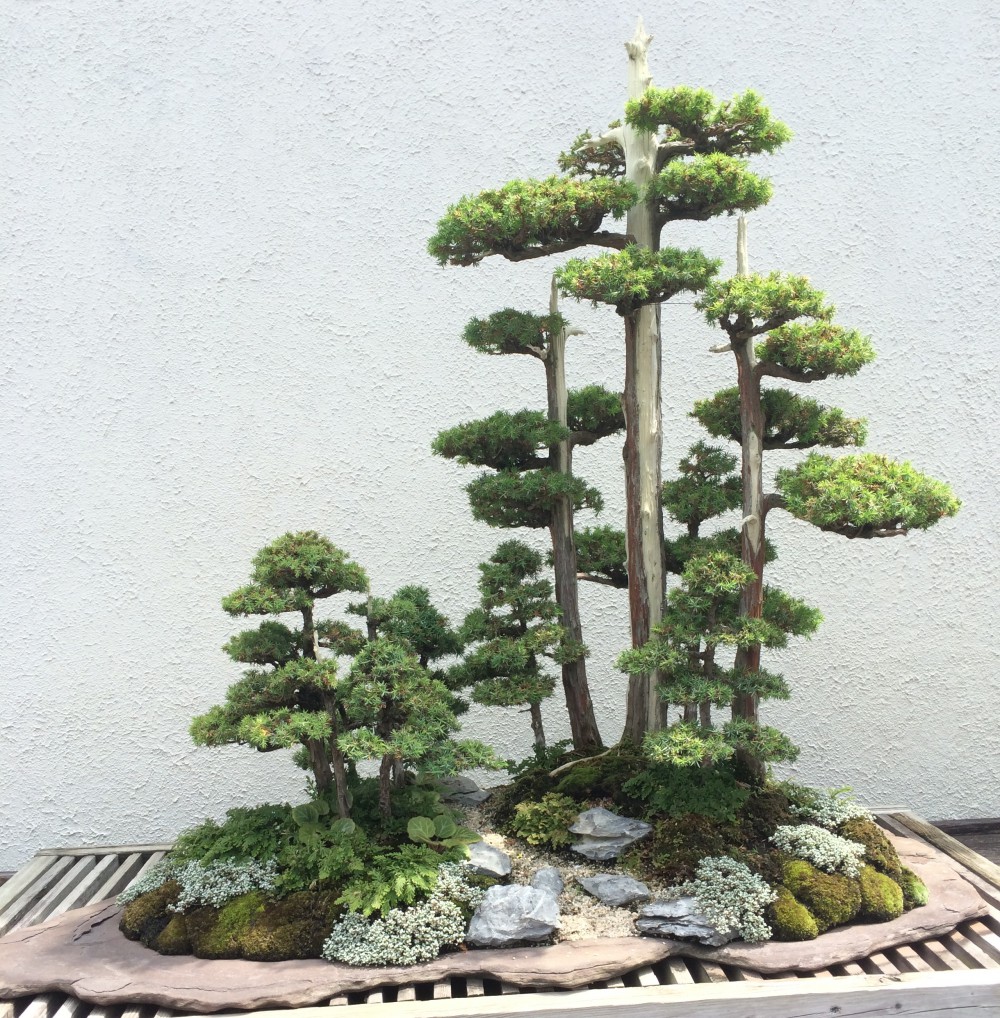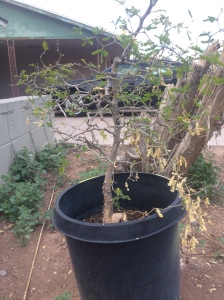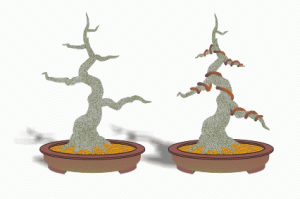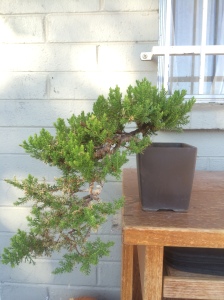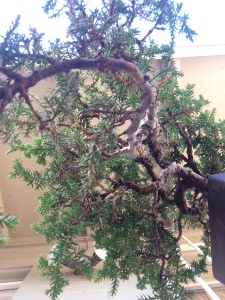A few weeks ago, I shared an incredible experience with some of the members of the Phoenix Bonsai Society. David Nguy, renown bonsai master and sensei, came from his home in southern California to instruct us on the styling principles of bonsai.
Everyone was to bring their personal tree for David to work on. At first I felt out of place. Almost everyone brought in a variety of juniper or other conifer while I chose a less traditional plant. I brought in a Texas Ebony (Ebenopsis Ebona), a North American native that thrives in the desert climate (More Info Here). My luck with non-native species has been horrible in the Phoenix climate. I needed something that could live comfortably through the summer. Here are some pictures of when I first brought it home:
As you can see, the leaves were starting to die due to change of season, but the tree was still very healthy. I chose it due to the great potential it possessed in that beautiful trunk. The trunk is the most important aspect of the individual tree itself because it is the artistic backbone of everything else. When you gaze upon a bonsai the first thing the eye is drawn to is the trunk. It needs to take the form of how a tree would naturally be growing in nature while at the same time conveying your tree’s personality.
The first thing you do before any styling is to decide where the front of the tree lies. Like many pieces of fine art, the artist intends the viewer to have a fixed perspective of the piece. The same holds true for the art of bonsai. Deciding where the front of your tree determines how the branches and pot will be arranged. You are then not mindlessly triming branches but rather methodically training them to fulfill a perspective you are trying to set in nature. David decided the front should be where the tree trunk is protruding up at the 5:00 position. This curve is soft but sturdy as the eye follows the trunk from the base to the apex.
The apex of the tree is the top most point and second most important attribute. It’s the end of your tree or where the eye will stop as it moves up the trunk. Here, after David lopped off a good number of unnecessary branches, he found the most powerful apex of the tree:
The apex’s job is to simply balance out the trunk as the tree comes to an end. There is only one apex in a bonsai, and it could be either living or dead wood. Because the trunk of this ebony is so dominant on one side, the apex must swing the opposite side of the trunk before coming back around. You can see David explaining this concept and showing how the apex will go once some wire is applied.
David told me how the branches will be arranged so it was up to me and his assistant to wire the tree. Wiring is technical work and especially challenging when your tree is covered in thorns. We spent a good half hour to 45 minutes just removing every thorn we could find because of how painful it would make the wiring process.
There are a few rules one must follow when wiring a bonsai:
1. Depending on which direction you want to turn the branches determines which angle you should wire from. The wire must wrap around the branch where the pressure of turn is most strong. For example, a branch that needs to be bent downward must have the wire come from the top. If you are bending to the right, the wire must come from the left of the branch. Here is a little picture that briefly outlines this practice:
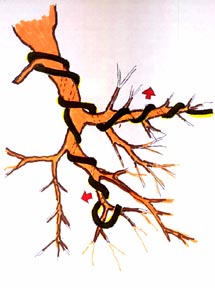
The arrows point to the direction the branch will turn. Notice the direction the wire is coming from.
2. Never cross wires. This is where a mathematical rather than artistic mind comes into play in bonsai. To properly wire a branch using multiple wires, all the wires must fall in line with each other without any crossing. You can see this can get difficult when you have a bunch of branches to bend in different directions and need to follow the rule #1 of proper wire placement. The reason you never cross wire is because it will make your job a living hell when you need to remove the wire and simply because it looks unclean. Bonsai is all about appearance at every step of the growing process.
3. Decide how you want your branches positioned before applying wire. If you put wire on your tree and start bending it multiple times until you find the “right” spot, don’t. When you bend a branch you are breaking the microscopic fibers of the branch, similar to how weight training breaks muscle fibers. Over time the branch cells heal the damaged tissues, solidifying the tree’s shape. If you bend it here and there over and over, you are just damaging the branch more and more which can lead to death to the branch. Yes, there is a thing called “working your tree to death” and you can just imply exactly what that means.
4. When applying wire, there needs to be a spot where you anchor the one end so it doesn’t move as you wrap the wire around the branch. Anchoring the wire around the trunk should be your last resort. Remember how bonsai is all about appearance at all stages of the growing process? Well, wire on trunk is unappealing and should be avoided. The best way to anchor a wire is to secure the one end to a nearby branch, briefly passing through the trunk, and then wiring up the next branch. Here is an image of what I am talking about:
You can see how there are only two pieces of wire but you can wire four branches with it, having both ends of the wire being the anchor for each other. David Nguy always says to “walk” the wire up a branch, never “jump” as this ensures a tight fight on the branch and avoids unwanted spaces that weaken the wire strength. He is referring to your thumbs and how the technique a true master has acquired. But of course with everything, this requires a lot of practice.
David’s assistant for the workshop and one of three apprentices he instructs in California, helped me with the wiring process. David’s initial trimming left what it seemed like an easy wiring job but it ended up taking us almost a full hour to get every branch completely wired properly. David finally came back around and worked like a true bonsai master, decisively placing each branch in relation to the front. When placing branches, you want to sculpt them in the shape of many small triangles, as is the underlying principle of asymmetric balance. Here is a little snip of him working my tree:
After all the work was complete, here are the results. It has come a long way since its days as nursery stock but still years from being finished. In fact, it will never be finished as it is a continuously growing piece of art. But for now, until spring, I will keep it in the large nursery pot and wait for the new leaves to sprout.
